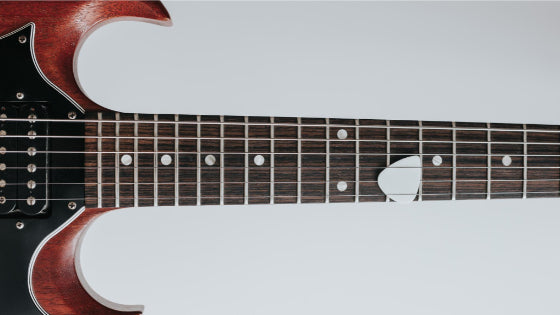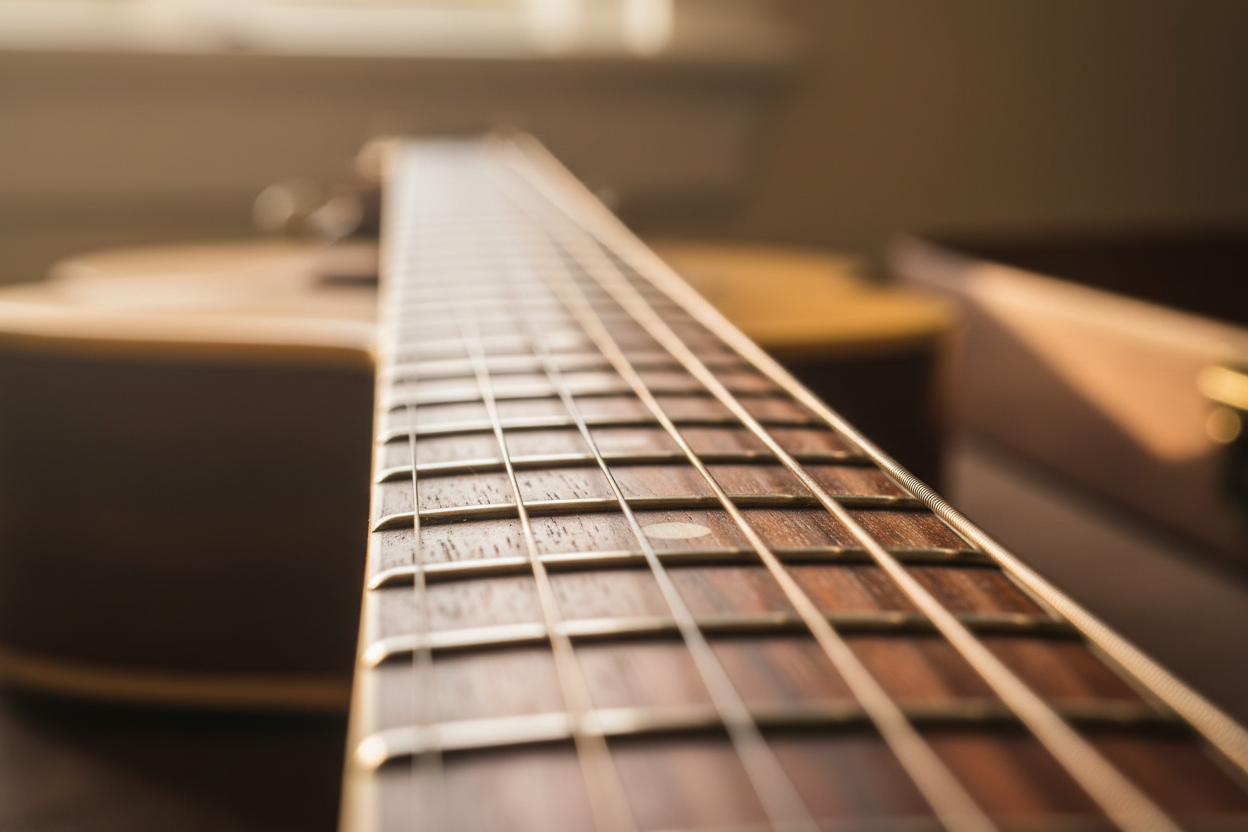If you’ve already gone through the importance of strings, tuning keys, nuts, resonance boxes, or pickup magnets, not much remains to review aside from the guitar frets and fretboards. While some guitar parts massively affect the guitar tone, playability, and quality, frets and fretboards are a matter of nuance, if not pure speculation.
In this article, we are going to review the importance of guitar frets and fretboard types found on the market and try to answer how much they affect the way you play the guitar and your guitar’s tone. As an overview, we can say that frets and fret materials affect you as a player much more than the fretboard itself, though the fretboard type does become significant the more experienced a guitar player is.
Let’s delve deeper into the world of frets and fretboards and figure out what we need to take into account when picking our new guitar.
Introduction to Guitar Frets
Frets are the analogy of keys on a guitar. While pianos have keys that roster a tone, frets do this on guitars. They are usually metal plates embedded in the fretboard in a particular length pattern and each fret corresponds to a note on a well-tuned guitar.
It has to do with how the strings and frets work together to make a tone. The shorter the string is and the more tension there is on it, the higher pitch tone it gives off. Frets are there to artificially shorten the note, producing higher tones (otherwise, you would need a harp, for example).
Frets are a kind of barrier that, along with a player’s finger, mimic a shorter string that resonates at a higher frequency.
This comes with a few implications. The first one is that a fret will do a good job if it rosters the string tightly. The second is, that a fret should “cut the string” so that it makes the least impact on the vibration of a string. Finally, the fret shouldn’t affect the tone’s pitch when we are playing. The better a fret does its job, the cleaner the sound is, and there’s more sustain.
A Fret’s Shape
The shape of a fret can affect the tone played on it. The fret shouldn’t be too narrow, or it could cut or damage the wire too fast. Too wide a fret is also a problem because it can mess with the precision of a delivered tone as well as give off rattling if the string is not pressed in the right position.
Since frets are usually glued to a fretboard, it is really important that they are tightly embedded in it. If the fret is loose, it will take up too much vibration and the string tone will just sound bad. This is where the fret and fretboard material work together to produce a long-lasting and quality guitar.
A fret should also be discreet, which means there isn’t much material “behind” the string that scratches the string while vibrating. This is a problem for guitar makers to solve and they are doing a good job at it, especially the known manufacturers.
However, frets can deform over time, slightly changing their shape, which can produce buzzing and tone-killing effects we want to avoid. This is why you should always pick a guitar with frets made of durable materials (like steel) and even consider changing frets after a couple of years of intense playing.
Standardized Frets
The height of the frets is also very important to pull off. It affects both the tone and playability of a guitar.
The tone can be affected in two ways. The first one is that some “behind frets” (closer to the 12th fret) are higher than the one you are playing. The wire can hit this fret and buzz, losing sustain. It can be countered by raising action (bending the neck), but this affects the overall tone layout and fret-to-tone ratio, rendering some guitars unplayable.
Another way a fret height can affect you is by slightly changing the ground for your play style. If you like to hit a string all the way to the fretboard, you’d need lower frets, otherwise, you’ll give a little more tension to the string, raising its pitch. If you want more sustain, you would look out for higher/larger frets.
Here is a list of the most common fret types:
6130: Very low and very wide Mid Jumbo (.106in x .036in)
6230: Old Fender frets, the smallest of them all (.078in x .043in)
6105: Most popular these days, slightly taller (.090in x .055in)
6150: Wide Vintage Jumbo, wider and slightly lower (.102in x .042in)
6100: Wider Jumbo frets (.110in x .055in)
The choice falls to personal preference, which needs some experience and playtime on different frets. It can also be the case that you’d play some songs better on one type of frets, while other songs are more comfortable on wider or taller frets.
The Issue of Tuning
There are slight differences and imperfections you can find on any guitar. These imperfections relate to the pitch of some notes, resulting in a couple of them not fitting perfectly when played together with other notes.
This happens practically all the time. The standard fretboard layout is never perfect, it’s just the one we’ve been rolling with the longest. When you tune your guitar to the standard tune, there will be discrepancies in various tones between 0.1 Hz to 10 or even 20 Hz. Most of the time, you won’t notice it, and popular music got us used to these slight discrepancies.
The math for deriving tones on a standard fretboard layout will always be off by a bit no matter how we tune the guitar. That’s why players usually avoid tuning the guitar to a specific chord, since that “perfect” tune for Amaj, for example, gives off a really weird and imperfect Dmaj.
This is actually a perk rather than a flaw. All string instruments experience these imperfections. On a guitar, we can utilize this fact and adjust our tuning to our needs. This happens often, like in RHCP Californication where Frusciante intentionally tunes the B-string differently, to give more resonance in parts of the song.
Fret Alignment
For this reason, there is the standard fret alignment we are all familiar with. The distance between frets on different wires is the same and is set about a couple of thousands of years ago. The idea is, if your song doesn’t sound nice in terms of pitch, you should use a slightly different tuning and probably settle for the least annoying option.
Another approach is to use curved frets found on some custom-made guitars. These guitars are made for a specific tuning and the frets are aligned differently across different strings to adjust to the perfect tone pitch for every note on the fretboard. The 12th fret is always in the middle as it’s set on the first harmonic, but the length between either fret for lower E and high e strings is different.
There are also microtonal guitar frets that have the option to move frets around, so you can set yourself for a non-chromatic scale, usually used in eastern schools of music.
Fretboard Materials
The bedding of guitar frets is the fretboard. While the importance of fretboard and neck shape is clear and does affect the playability of a guitar, there isn’t a clear agreement on how the fretboard material affects the tone of a guitar.
While some say that they hear no difference whatsoever between different fretboard materials (especially on electric guitars), others refer to science and the fact that the factors such as elasticity can “soak” or emphasize some vibration of strings, slightly affecting the tone.
My opinion is somewhere in between – it does make sense that fretboard material can affect the guitar’s tone, even the electric ones, but the differences now are so minuscule that we can ignore it for most of our guitar-playing careers. If we had to pick between quality wood and low-quality wood, or some weird materials like marble or ivory (like they used in in 16th-ish century), we’d notice more buzz here and less sustain there. But now, we can boil it down to the looks and colors, and maybe playability.
Playability can be the key term here since fretboard woods mostly vary by the difference in grain and grain patterns. These various grains and grain patterns can affect the feel and grit during playing – how the fretboard “catches” our wire and how much it lets it slide. High-grain woods would then be better for bending for some players, and vice versa.
Wood Categories
Fretboard woods come in two basic varieties – the traditional ones, which are harder and harder to find, and the new, replacement woods that usually do just as well.
I am making this distinction because the three most popular woods (rosewood, ebony, and hard maple) are more and more endangered every year. The price has gone up significantly and some manufacturers were penalized for the unlawful use and acquisition of these rare woods.
On the other hand, many alternatives have been found and it’s more than worth exploring them, especially because many of them serve the same purpose with astronomically minimal differences.
In any case, I will mention the three traditional types, since they serve as a model for the alternatives.
Maple
Maple is a generous material for fretboards because of its grain and hardness/flexibility ratio. Maple fretboards are usually not distinctive from guitar necks since maple can be used for both. Fender is a classic example of all-maple necks and fretboards.
Maple gives a bright and light yellow-brown color that looks nice with various types of guitar bodies. Transparency of the fretboard compared to frets and fret markers also play a role for some players.
Maple comes in two varieties, hard maple, and soft maple. Hard maple is harder to find as we speak, while soft maple is becoming the new standard.
The differences between the two are not that obvious. It brings out a clear tone with more sustain due to its hardness. It can also come in various grain patterns and it is popular among shredders since it’s responsive and a bit slippery, making string bending faster, though less precise.
The downside is the maintenance, due to its light color. Any residue from fingers and air dust is quickly noticeable, and it can easily build up to affect the tone. For this, maple fretboards need cleaning much more often.
Rosewood
Rosewood is the standard in fretboard building since it has the perfect balance of visual, playing, and arguably sound appeals. Masters often describe it as rich, and warm, with the right balance of bright and low frequencies. It is said that it soaks unwanted frequencies well.
Rosewood comes in several nuances of red, dark red, and brown, favored by Gibson. The sturdiness and durability also come into play – almost none of the rosewood players ever think of replacing their fretboard.
Maintenance is pretty easy and it doesn’t demand too much, but an occasional light scrub and potentially oiling in some situations (in places where the wood can dry faster).
The most asked-for type is the Brazilian rosewood, which brought to extreme risk of extinction. A popular alternative is the slightly lighter Indian rosewood, which is quickly taking on the production pressure of its South American relative.
In both cases, the grain is grittier than maple so the surface doesn’t feel as smooth. Bending has more friction but plain wire pressing will keep the string in its place better than maple.
Due to its popularity and scarcity, the manufacturers have been working for decades to develop alternatives, and sometimes, this was highly successful, so much so that some popular guitarists started giving up on rosewood and going with the alternatives.
Ebony
Ebony is already an expensive wood due to its amazing set of features that includes amazing color, durability, and relatively easy processing. It gives off ash to black colors with various grain patterns that just feel natural and nice for the eye.
Ebony dries fast and it’s more susceptible to the elements. It requires care and maintenance if you want to avoid cracking, depending on your region and the place you keep your guitar at.
The benefit is the snappy, metal-ish sound with more resonance and sustain due to its hardness. If maintained correctly, it keeps the same tone structure for a long and can serve generations. The gritty grain is even less slippery than the rosewood, and bending gives that slower, duller, yet more aggressive gain.
However, it’s important to know that growing ebony wood takes decades. It’s just impossible to keep up with the demand that in no way limits to fretboards (there’s furniture and other uses). If we keep up like this, we won’t have ebony at all. It’s highly endangered and the acquisition of ebony in some instances was rendered illegal.
New Fretboard Materials
Thankfully, guitar manufacturers have done a great job in finding alternative materials, mostly modeled by the three fretboard superstars. The list is long and doesn’t limit to natural woods – some manufacturers made progress with affordable yet quality synthetic materials. Here are some that are currently gaining momentum.
Walnut
Walnut is a natural choice due to its sturdiness and great grain. The sound is often described as crispier, and it’s maintained its popularity because of its sturdiness.
Pau Ferro
This type of ironwood is a common replacement for rosewood with some perks on its own. It is grainier than rosewood, therefore smoother, giving more attack and a little bit more treble. It also stays in the reddish color pallet.
Padauk
It is an interesting wood that many consider most similar to rosewood. The difference some may feel is a little faster tone decay, but more overtones and depth.
Richlite
This is the first synthetic fretboard material we are mentioning. This carbon-fiber material has become a feasible alternative for ebony, as it gives off a very similar experience.
Rocklite
Another alternative to ebony is Rocklite. It’s a composite material that even mimics the natural grain of ebony as well as the color and tonal features.
Indian Laurel
This is probably the most eco-friendly option to replace rosewood for now. Guitar demand has exploded in the past 40 years, and it seems that Indian Laurel is the most sustainable option so far. Enthusiasts would insist it is a fretboard wood with its characteristics, yet beginners can enjoy the common elements of the rosewood feel.
Written by Marko Jovanovic




